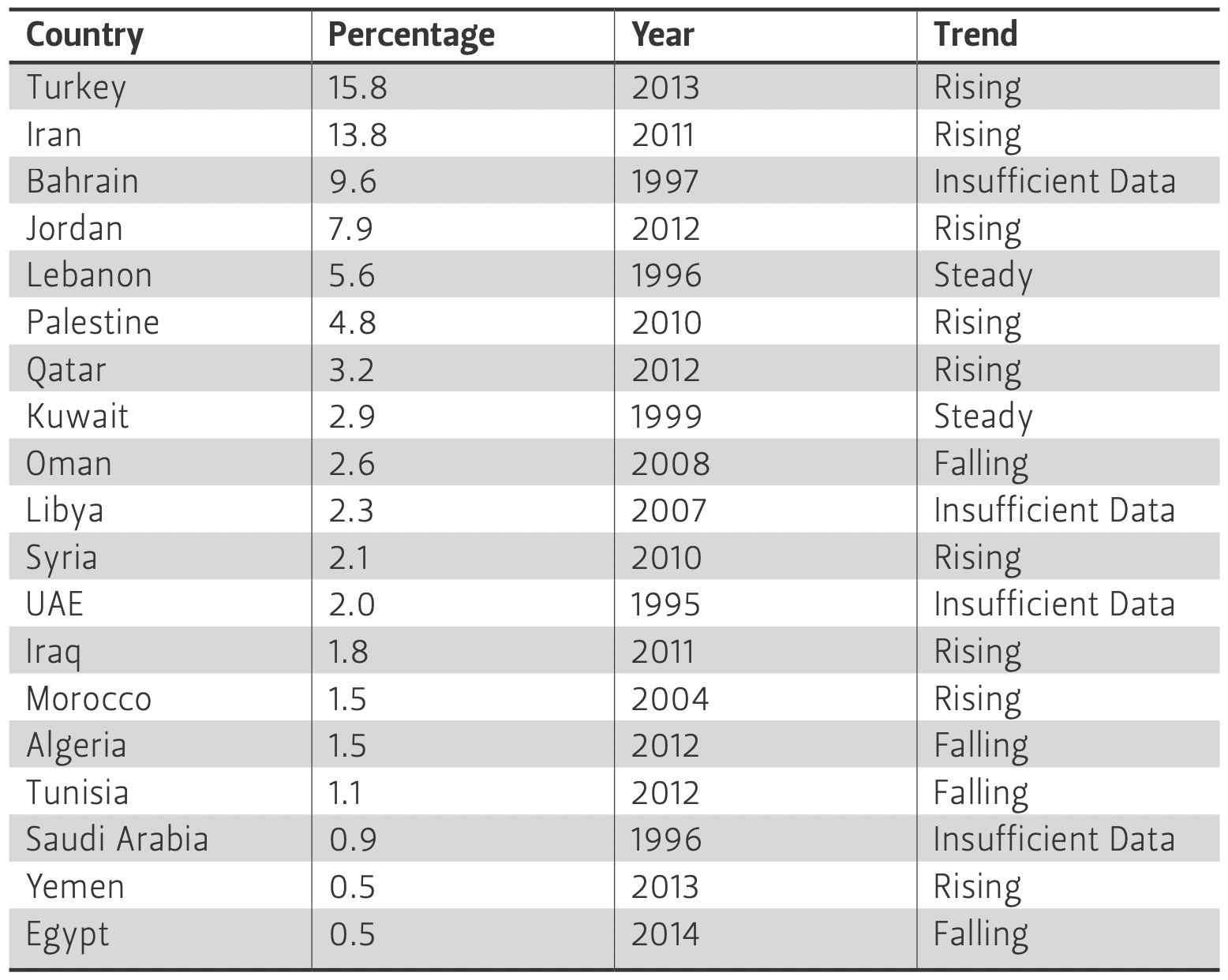Contraceptive Choice Among Women in the Middle East

Table of Contents
Author(s)
Ariana Marnicio
Former Research AnalystShare this Publication
- Download PDF
- Print This Publication
- Cite This Publication Copy Citation
Marnicio, Ariana. 2015. Contraceptive Choice Among Women in the Middle East. Issue brief no. 12.03.15. Rice University’s Baker Institute for Public Policy, Houston, Texas.
Introduction
Contraceptive choice is often framed as a women’s issue, with contraceptive policies targeting women of reproductive age. While several Middle East countries have policies in place to increase the availability of contraceptives for the purposes of family planning, even subsidizing them in some cases, it is more contentious in the region to advocate for condom use. Modern contraceptive methods, such as condoms, can be stigmatized in Middle Eastern culture due to their perceived connection to illicit sexual activities, and some believe condoms to be incompatible with the teachings of Islam.
Women’s health goes beyond pregnancy and other maternal health issues. It must also include the prevention of sexually transmitted infections (STIs) that can lead to significant morbidity, and in some cases mortality, if left untreated. Condoms are one of the cheapest and most reliable methods of preventing the spread of STIs, and can also prevent unwanted pregnancy. Given the prophylactic nature of condoms, it is critically important that women understand their role and are able to negotiate their use with their sexual partners. This issue brief will discuss condom use rates across the Middle East, the role of cultural orientations in contraceptive choice, regional programs that promote condom use, and policy recommendations to help protect women.
Rates of Condom Use
Measuring rates of condom use or conducting surveys on sexual behavior in the Middle East can be difficult and controversial. One survey conducted within the Middle East, the Global Online Sexuality Survey (GOSS), is conducted anonymously online, reducing the feelings of embarrassment that may occur if these topics were discussed in person. According to the survey, only 56 percent of the male participants had ever used a contraceptive method with their partner, and only 16 percent had used condoms.1 A previous study from Egypt placed condom use at 23.9 percent,2 and in a study conducted in Jordan, 14 percent of women and 17 percent of men surveyed reported using condoms with their marital partners.3 Although condom use rates around the region differ, they are generally low.
Table 1 — Rates of Condom Use Among Married Women in the Middle East

The United Nations Statistics Division4 has compiled data on condom use rates with the help of local governments from around the world. Table 1 features 19 Middle East countries, listed in order from highest to lowest condom use rates among married women of reproductive age (ranging from 15 to 49 years old). Additionally, the table features the year of the most recent data collection and national variations in condom use over time.
Non-Arab countries in the Middle East (i.e., Turkey and Iran) have significantly higher rates of condom use compared to their Arab neighbors. In fact, the average condom usage rate of all the Arab nations listed is just under 3 percent. Overall, the countries of the Levant, such as Jordan, Palestine, and Syria, fare better than countries of North Africa or the Gulf. Interestingly, countries that have a higher population of Shi’a Muslims, such as Iran, Bahrain, and Lebanon, have higher rates of condom use, a trend that has been observed in other analyses.5 There does not seem to be a direct correlation between wealth and condom use, as Saudi Arabia ranks third to last and most other oil-rich Gulf countries rank below the average.
Although these low rates could be attributed generally to the high social importance of having children, other social and cultural factors certainly play a role. Knowledge about condoms and their use is equally low and troubling from a health perspective. In a 2014 study conducted in Jordan, only 38 percent of women knew that condoms could help prevent HIV infection.6 In yet another study, only 19 percent of the women surveyed knew that condoms could be used for reasons other than preventing pregnancy.7 A quarter of women from a Jordanian Department of Statistics study did not know where to buy condoms in the first place.8
Condom use must be carefully negotiated between partners in every cultural context. This negotiation can be particularly difficult because condoms are a method of contraception that requires the cooperation of a man, rather than being solely a woman’s responsibility. In the 2014 Jordanian study, a staggering 82 percent of women reported that they were afraid to ask their husbands or boyfriends to use a condom. Furthermore, 71 percent reported that their husbands or boyfriends refused to use condoms. These sentiments could be partially explained by the high rate of reported dissatisfaction (41.9 percent) with condom use in the GOSS survey.9
As mentioned above, many people feel uncomfortable going to purchase condoms, or may not even know where to find them. The root of this discomfort could be the misconception in the region that condoms are only used in extramarital sexual relations, and that if an individual were having sex with their spouse, such methods of protection would be unnecessary. It is not uncommon for pharmacy technicians to pass judgment on customers aiming to purchase condoms. This discomfort has inspired several companies to sell condoms through websites or smartphone apps. Yalla Condoms, a Beirut-based startup, delivers condoms in discreet packaging straight to customers’ homes. The site also offers products such as feminine hygiene products and pregnancy tests. Durex, a well-known condom manufacturer, has also produced the SOS Condoms app for condom delivery, which is now available in Dubai. The success of these initiatives indicates that current availability is inadequate.
The Role of Government: Lessons Learned
Governments play a critical role in promoting both the use and preferred method of contraception. Ayatollah Ali Khamenei, supreme leader of Iran, has repeatedly condemned contraception, attributing its use to the Western lifestyle.10 Iran previously implemented an incredibly successful birth control program for more than 20 years, promoting vasectomies and contraceptive use and providing family planning counseling and education, leading to the largest drop in fertility rates of all nations worldwide from 1980 to 2009.11 Since then, the programs have been scaled back, with significant funds instead invested to promote population growth, thereby garnering the political support of the nation’s religious conservatives. Turkish President Recep Tayyip Erdogan has also spoken out against contraception, deeming family planning an act of “treason,” and linking unbridled family growth to nationalism and the strength of future generations.12 Regardless of the religious acceptability of contraception, Islamist political leaders are framing it as an Islamic and nationalist concern.
The previous family planning program in Iran was highly effective and an excellent model for other Muslim majority countries to emulate. While the initial decision in the 1980s to promote family planning and contraceptive use in Iran was purely secular, religious officials were sought to legitimize these policies by issuing religious edicts in support of contraception, confirming that Islam presented no barrier to family planning. Now, government aims have shifted and political leaders claim that the selfsame religion condemns contraception, and urge the countries to adhere to their natalist policies to strengthen the nation. It is clear from these countries’ prior actions that condoms and other forms of contraception are not incompatible with Islam or with regional culture, but rather that usage rates have more to do with political motivations and policy emphasis.
The Middle East region places great cultural emphasis on families. There are many excellent NGOs working in the region that provide family counseling and family planning services, and international organizations are helping to provide them with the prerequisite training and resources. With local governments fluctuating on their stance on family planning, nongovernmental organizations and institutions should champion contraception. Religious leaders have been used effectively to legitimize these policies and could act as advocates within the community.
Family planning organizations that have historically supported the use of IUDs and other modern methods of contraception should also encourage condom use among married couples. Although the prophylactic role of condoms must be emphasized in all family planning services and outreach activities, condoms should not be branded as necessary only in cases of STI risk. These organizations should work to train not only health care providers, but also pharmacy technicians in how to distribute contraceptives in an informative and nonjudgmental fashion. Women, in particular, must be targeted by awareness raising campaigns, as they are typically responsible for family planning implementation. There is ample evidence that women in the Middle East are not provided with the necessary education or the resources with which to protect themselves from STIs or unwanted pregnancy, and that governments are capable of shaping public opinion on these issues.
Endnotes
1. Osama Shaeer and Kamal Shaeer, “The Global Online Sexuality Survey (GOSS): Ejaculatory Function, Penile Anatomy, and Contraceptive Usage among Arabic-Speaking Internet Users in the Middle East,” Journal of Sexual Medicine 9(2012): 425-433.
2. I. A. Kabbash, N. M. El-Sayed, A. N. Al-Nawawy, I. K. Shady, and M. S. Abou Zeid, “Condom use among males (15-49 years) in Lower Egypt: knowledge, attitudes and patterns of use,” Eastern Mediterranean Health Journal 13, 6(2007): 1405-1416.
3. Esra Alkhasawneh, Willi McFarland, Jeffrey Mandel, and Vidya Seshan, “Insight into Jordanian thinking about HIV: Knowledge of Jordanian men and women about HIV prevention,” Journal of the Association of Nurses in AIDS Care 25, 1(2014): e1-e9.
4. United Nations Statistics Division, “Current Contraceptive Use among Married Women 15-49 years old, condom, percentage,” accessed September 17, 2015, http://mdgs.un.org/unsd/mdg/SeriesDetail.aspx?srid=732&crid=.
5. Robin M. Farabee-Siers, Condom use and the spread of HIV/AIDS in Muslim-majority countries of the Middle East and North Africa (Thesis, University of Pittsburgh, April 2008).
6. Alkhasawneh, McFarland, Mandel and Seshan, “Insight into Jordanian thinking about HIV: Knowledge of Jordanian men and women about HIV prevention,”
7. Salah Mawajdeh, Raeda Al-Qutob, and Amy Schmidt, “Measuring Reproductive Morbidity: A Community-based approach, Jordan,” Health Care for Women International 24(2003): 635-649.
8. Department of Statistics, Amman Jordan, Jordan Population and Family Health Survey 2012, October 2013.
9. Shaeer and Shaeer, “The Global Online Sexuality Survey.”
10. Saeed Kamali Dehghan, “Iran Considers Ban on Vasectomies in Drive to Boost Birthrate,” The Guardian, April 15, 2014, accessed November 18, 2015, http://www.theguardian.com/world/2014/apr/15/iran-ban-vasectomies-birthrate.
11. Palash Ghosh, “Iran Scales Back Birth Control Programs, Seeks Baby Boom,” International Business Times, August 2, 2012, accessed November 18, 2015, http://www.ibtimes.com/iran-scales-back-birth-control-programs-seeks-baby-boom-737378.
12. AFP, Istanbul, “Erdogan Slams Birth Control Use as ‘Treason’”Al Arabiya News, December 22, 2014, accessed November 18, 2015, http://english.alarabiya.net/en/News/middle-east/2014/12/22/Erdogan-slams-birth-control-says-one-or-two-children-not-enough-.html.
This material may be quoted or reproduced without prior permission, provided appropriate credit is given to the author and Rice University’s Baker Institute for Public Policy. The views expressed herein are those of the individual author(s), and do not necessarily represent the views of Rice University’s Baker Institute for Public Policy.


